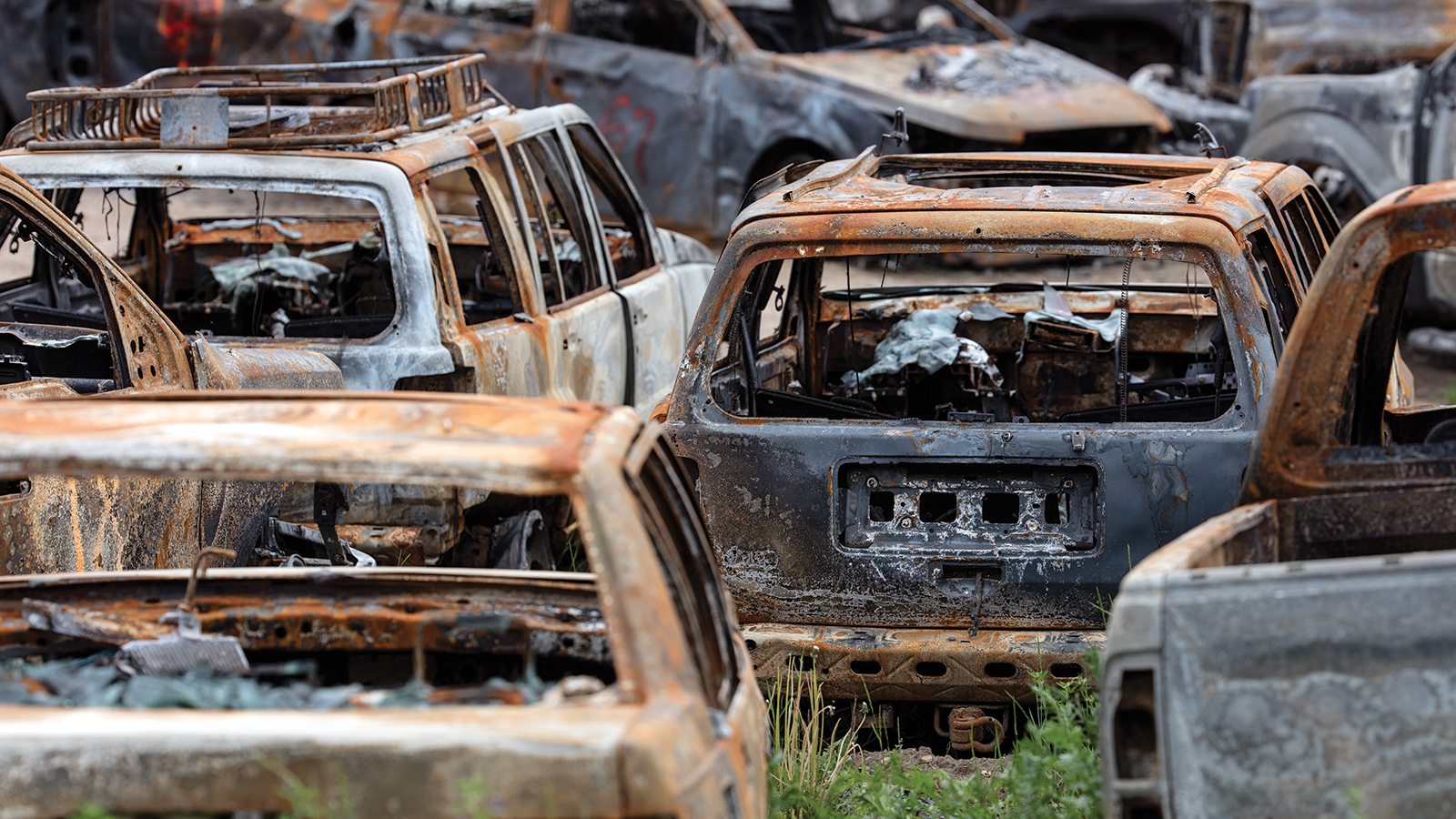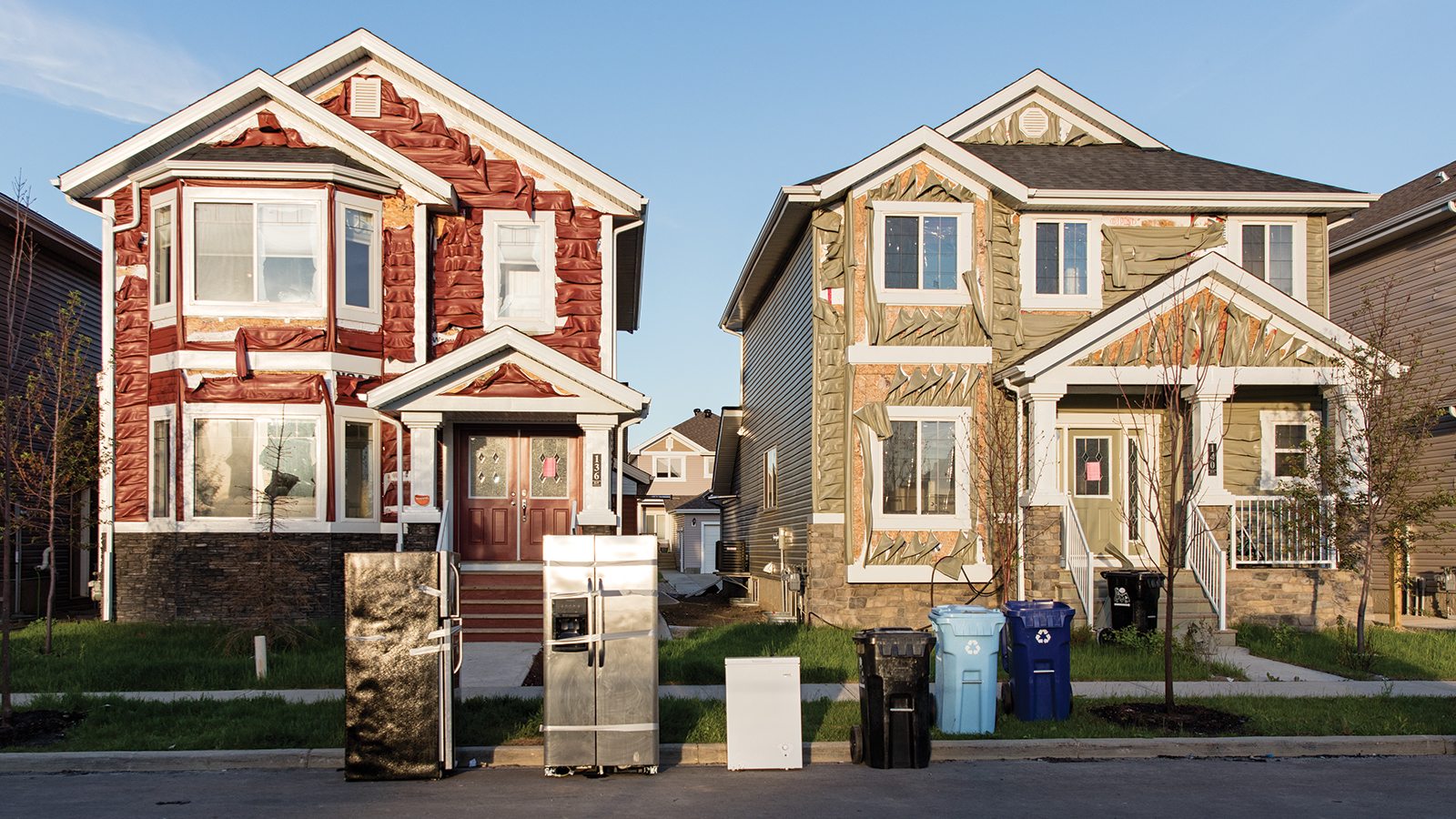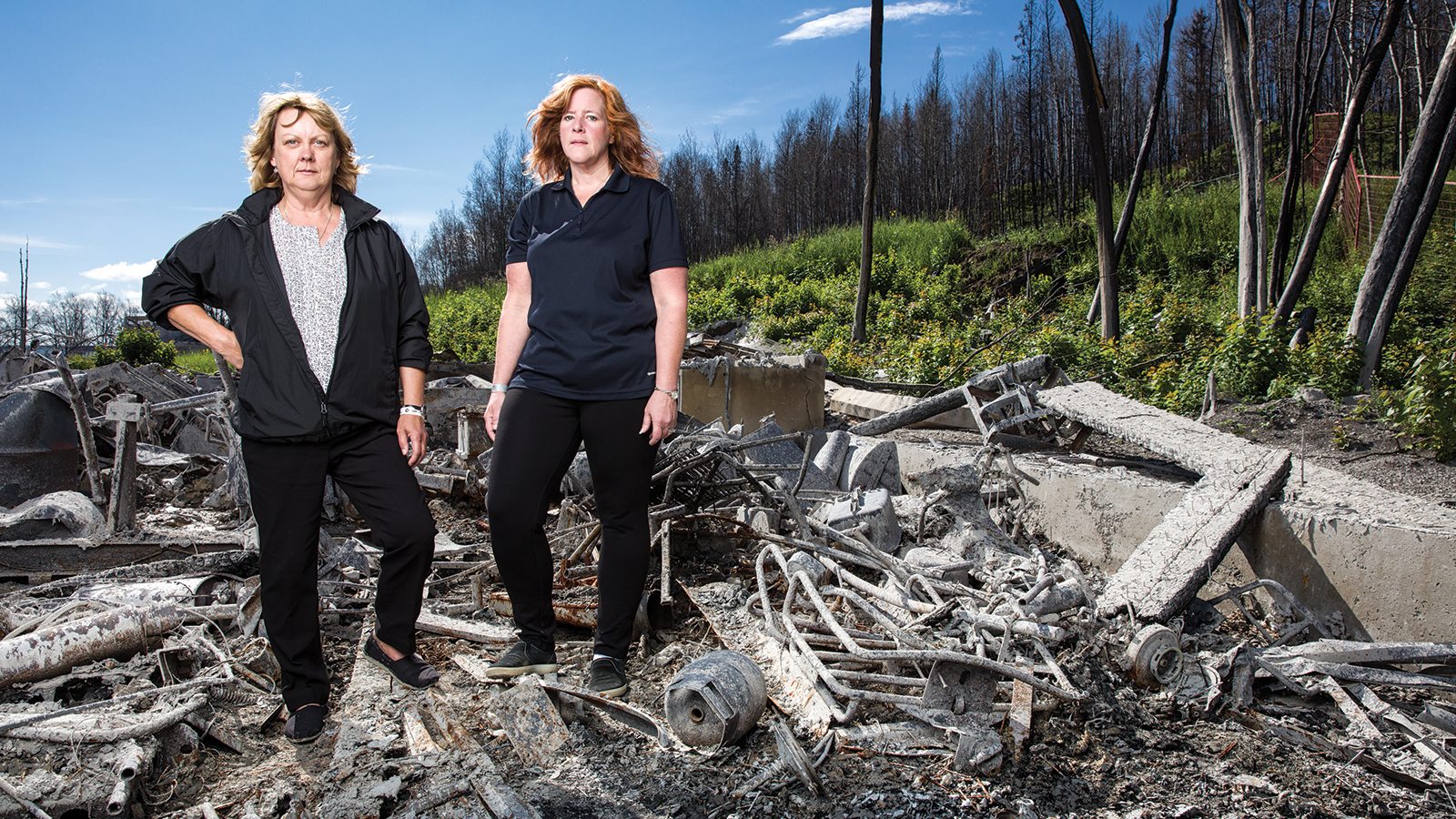Shortly after 1 p.m. on May 3, Steve Russell climbed the steep hill behind his Waterways home to check on the advancing Fort McMurray wildfire. At a news conference two hours earlier, fire officials noted that while the fire appeared to have died down—due to a temperature inversion, whereby hot air at higher altitude traps smoke close to the ground—it was likely just an illusion.
What Russell saw as he peered across the ridge was horrifying: The inversion had lifted and Beacon Hills was fully engulfed in flames. The fire was quickly pushing toward Waterways, one of the city’s oldest neighbourhoods. Russell let out a deep sigh and climbed back down the hill to tell his wife Monica Thompson they had 30 minutes to leave.
Thompson grabbed her passport, overnight bags and some food for their dog, Molly. “I walked right by my laptop sitting on the dining room table, as I thought we’d be coming back—I didn’t think this was a forever thing,” she says. Not a bad assumption considering their two-storey, 1940s log home had survived previous natural disasters in the Wood Buffalo area.
Their home, known by locals as “the log house on top of the hill,” attracted a parade of trick-or-treaters every Halloween—as well as ongoing rumours about its occupants. Some neighbours speculated the owners must be eccentric artists, but Thompson worked as an auditor for an oil company and Russell runs a tiling business.
The pair climbed into their vehicles and drove down to the banks of the nearby Clearwater River. They stayed there for several hours, but as the smoke thickened around them, they realized they’d have to drive out of the city. Before leaving, Thompson called AMA Insurance to let them know she’d need to file a claim: Her house had just burned down.
As Thompson was packing her bags, Narinder Goraya gazed out the south-facing window of Fort McMurray’s AMA centre. Goraya was astonished by the flames towering up behind the nearby pharmacy. “You could see panic in the streets,” he says. “It was almost as if somebody dropped a bomb.”
Evacuation orders hadn’t yet been issued for downtown, but the centre manager’s first priority was to get his 26 employees out and reunited with their families. After ensuring everyone’s safety, Goraya rushed to collect his wife, 75-year-old mother and dog, Rufus. He didn’t take so much as a toothbrush as he and his family fled the community they’d called home for 26 years.
Fifteen hours later, as he approached Edmonton, the stress finally hit him: “I just broke down and started crying,” Goraya explains. “Then this guy got out of his truck, gave me a big hug and pointed out his house, saying if there’s anything my family needs, just knock on his door—true humanity.”
For Thompson, Russell, Goraya and the rest of Fort McMurray’s 90,000 residents, the gravity of the situation didn’t fully set in until the evacuation order was announced later that day. Strong winds and dry conditions had fuelled the growth of the monster blaze. A change in weather conditions was the only thing that could stop it now.

The wildfire was truly catastrophic, unlike anything the province or the country had ever experienced. It quickly became Canada’s costliest natural disaster. According to the Insurance Bureau of Canada, damage has been pegged at more than $3.5 billion, with 27,000 property claims and 12,000 auto insurance claims filed—and 500,000-plus hectares of land burned.
On the evening of May 3, evacuation centres were set up across the province. About a third of Fort Mac residents made their way to Lac La Biche and a couple thousand more were housed in four Calgary reception centres. But most evacuees wound up in Edmonton.
At the Northlands site, cots and emergency-relief supplies were brought in to accommodate 1,300 people and their pets. The Canadian Red Cross arrived almost immediately to provide emergency resources and assistance to evacuees trickling in overnight. By noon the next day, AMA Insurance was also on scene in Edmonton and Lac La Biche, issuing emergency cheques on the spot, to ensure people had immediate access to funds to care for their families.
Over the next few days, thousands of people registered with the Red Cross at the Northlands centre in Edmonton.
At the evacation centres, it was an emotional roller coaster for everyone who pitched in to help. Dean Castle, an AMA Insurance underwriter, recalls helping a mother who thought she had no property insurance: “But it turns out she was covered, so we were able to write her a cheque, allowing her and her sons to move out of the evacuation centre,” he says. “She just sat there and cried tears of gratitude because we were going to look after her. It was pretty amazing.”
The day after being evacuated, Monica Thompson and Steve Russell got a phone call from their insurance adjuster, Christie Belok-Bunn. “I wasn’t sure if our insurance covered wildfires. I was convinced we’d be wiped out,” Thompson says. Belok-Bunn immediately assured them they were indeed covered. “I can’t even explain what peace of mind that news gave us,” Thompson says. “Just total relief.”
Adjuster Belok-Bunn is herself a Fort McMurray resident and evacuee. The night before, she too had made a long 10-hour evacuation journey, arriving in Edmonton in the early morning hours. “I didn’t have time to focus on my personal situation—we arrived 5:30 a.m. and I was in the office working by 10. I just knew many people were going to need help.”
Being a Fort Mac resident helped her comfort and support her clients: “I think it helps people if they know I’m not going anywhere—I’ll be with them through the whole process, until everything’s been taken care of and life gets back to normal. Or as normal as it can be,” Belok-Bunn says.
Disasters mean disruption, sorrow and suffering. But they are also times when people can—and must—come together as a local and national community. In the weeks following the fire’s outbreak, Canadians from across the country pitched in. From corporate donations by oil and gas companies, transportation businesses and pro sports teams to contributions from average citizens, aid poured in.
In Lethbridge, AMA along with local police and fire departments hosted a breakfast that raised more than $28,000 for Fort McMurray evacuees. AMAwas also one of many sponsors who participated in the largest single public fundraising effort, Fire Aid—a benefit concert that raised over $2 million for the United Way. In total, the Canadian Red Cross received $130 million for recovery efforts in the Wood Buffalo Municipality, with most of it still to be matched by the federal and Alberta governments.
As fundraising efforts continued, Fort McMurray residents were allowed to start returning home about a month after the largest evacuation in recent Canadian history. Firefighters man-aged to save approximately 90 percent of the city. But sadly, nearly 90 percent of Waterways had succumbed to the fire, with a large number of homes lost in Abasand and Beacon Hill, among other neighbourhoods.
On the morning of June 4, Russell and Thompson visited their home for the first time since the fire. The log house, like so many other homes in the path of the flames, had completely crumbled under the intense heat. All traces of the couple’s furniture, clothing, laptops and mementos were gone.
“At that moment, we started the process of disconnecting from our old home,” Thompson says. As she painfully sifted through the rubble, she managed to find a piece of her favourite pottery set, a puddle of melted gold jewellery, a ruby from her father-in-law’s wedding ring and a bird bath. But after less than a half hour, she felt compelled to leave. “I just didn’t want to spend any more time there.”

Narinder Goraya recalls the taste and smell of wet ash lingering in the air upon his return to Fort McMurray. “Parts of the city looked like a scene out of a movie: As far as the eye could see, nothing but charred trees and black soil. It was a horrible sight,” he says. “But you just keep thinking about what you have to do and that you have to be brave.”
Goraya was one of the lucky ones who suffered very little property loss. But in a community as small as Fort Mac, it was inconceivable to think that he wouldn’t know someone who was returning home to nothing. Two AMA employees whom he had evacuated, with only the clothes on their backs, lost their homes. “They’ve lost so much, but they’re driven and are trying to do their best under the circumstances. They really are the unsung heroes,” he says. “Everyone has been so, so supportive.
This situation has brought us together as a centre in Fort McMurray,” Goraya explains. “And it’s drawn us closer as a family with the whole of AMA.”
It will undoubtedly be a long time before life returns to normal in Fort McMurray. But on July 1, the community came together for the first time since the evacuation in a moment of celebration. Record crowds lined Franklin Avenue to watch the city’s annual Canada Day parade. The procession included marching bands, high school grads and AMA’s colourful cityscape float. Of course, the loudest cheers were reserved for firefighters, police officers and other first responders who battled to save the city.
When the fire broke out on May 3, Monica Thompson and Steve Russell were in the process of building their retirement home in Tawatinaw, east of Westlock. With their primary residence now gone, they feel the pressure to complete the Tawatinaw house before winter sets in.
Thompson took an early retirement package from work in order to help Russell finish the build. “Steve needs the support to get this done and get a roof over our heads,” Thompson says. “We may not be living in Fort McMurray in the future, but so much of our lives has been here. We’ll be involved in the community, in one way or another.”
The fight to save Fort McMurray united not only Albertans, but Canadians across our land. Among flames, smoke and ash, we learned our communities are braver, stronger and more resilient than we ever thought possible. The outpouring of support shown by strangers, near and far, and by friends, family and neighbours is a story of remarkable empathy and compassion. Rebuilding Fort McMurray will take a long time, but it won’t be done alone. We’ll build it together—Alberta strong.

BY THE NUMBERS
A look at the fire’s impact and how AMA was able to help
• Food donations: 1,608 kg
• Emergency relief supplies collected at AMA centres: 2,947 kg
• Replacement driver’s licences issued: 595
• Replacement birth certificates issued: 161
• Alberta Health Care Cards issued: 197
• Interactions on AMA social media channels: 38,806
• Trips rebooked for AMA travel customers: 200
• Served at Lethbridge Pancake Breakfast (hosted by AMA and local emergency service providers): 2,400 sausages + 2,500 pancakes
• Raised for Red Cross by AMA and CAA employees and members after AMA and government matching: $518,000
• Teddy bears given to kids: 50
• Roses distributed on Mother’s Day: 500
• Hugs given: INFINITE
